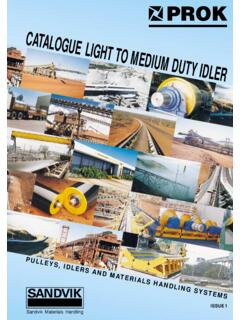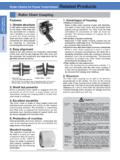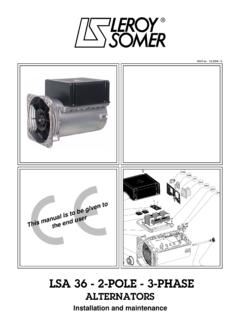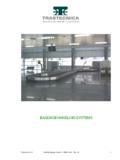Transcription of How to Design Efficient and Reliable Feeders for …
1 One Technology Park Drive Westford, MA 01886-3189 Tel: (978) 392-0300 FAX: (978) 392-9980 Also: San Luis Obispo, CA Toronto, Canada Vi a del Mar, to Design Efficient and Reliable Feeders for Bulk SolidsbyJohn W. Carson, Petro, feeder is an extremely important element ina bulk material handling system, since it is themeans by which the rate of solids flow from abin or hopper is controlled. When a feederstops, solids flow should cease. When afeeder is turned on, there should be a closecorrelation between its speed of operation andthe rate of discharge of the bulk differ from conveyors in that the latterare only capable of transporting material, notmodulating the rate of flow. Dischargers arealso not Feeders . Such devices are sometimesused to encourage material to flow from a bin,but they cannot control the rate at whichmaterial flows.
2 This requires a TO STARTV olumetric or Gravimetric?There are two basic types of Feeders used inindustrial plants: volumetric and its name implies, a volumetric feedermodulates and controls the volumetric rate ofdischarge from a bin ( , cu. ). Thefour most common types of such Feeders arescrew, belt, rotary valve, and vibrating pan. Agravimetric feeder , on the other hand,modulates the mass flow rate. This can bedone either on a continuous basis (the feedermodulates the mass per unit time of materialdischarge) or on a batch basis (a certain massof material is discharged and then the feedershuts off). The two most common types ofgravimetric Feeders are loss-in-weight andweigh Feeders should be used wheneverthere is a requirement for close control ofmaterial discharge.
3 Examples include whenthe feed rate uniformity must be better than 2%, or sample collection times must be lessthan about 30 sec. A gravimetric feedershould also be used when the bulk density ofthe material for feeder SelectionNo matter which type of feeder is used(volumetric or gravimetric), it should providethe and uninterrupted flow of materialfrom some upstream device (typically a binor hopper) desired degree of control of dischargerate over the necessary withdrawal of material throughthe outlet of the upstream device - This isparticularly important if a mass flowpattern [1] is desired, so as to controlsegregation [2], provide uniform residencetime [3], minimize caking or spoilage indead regions, with the upstream device suchthat loads acting on the feeder from theupstream device are minimal - Thisminimizes the power required to operatethe feeder , particle attrition, and abrasivewear of the feeder , plant personnel prefer a certain type offeeder because of experience (good or bad),availability of spare parts, or to maintainuniformity for easier maintenance throughoutthe plant.
4 Such personal preferences canusually be accommodated, since in general,several types of Feeders , provided they aredesigned properly, can be used in major considerations in deciding whichtype of feeder to use are the properties of thebulk material being handled and theapplication. Tables I and II provide insightinto which of four common types of Feeders isbest suited to each of these areas, and Table IIIprovides typical Design limits for FEEDERSS crew Feeders are well suited for use with binshaving elongated outlets. These Feeders havean advantage over belts in that there is noreturn element to spill solids. Since a screw istotally enclosed, it is excellent for use withfine, dusty materials. In addition, its fewermoving parts mean that it requires lessmaintenance than a belt feeder .
5 Screw feederscome in a variety of types, with the mostTable I: feeder Selection Based on MaterialConsiderationsVariableScrewBeltR otaryValveVibratingPanMax. practicalparticle sizeUp to 1/3 ofmin. pitch16 in. andlargerParticles degrade(attrit) easilyFairGoodFairGoodMaterial is a drypowderGoodFair2 ExcellentPoor2 Material issensitive to over-pressureFairGoodFairPoor1 Depends on feeder When used with slide gate for initial II: feeder Selection Based on ApplicationConsiderationsVariableScrewBe ltRotaryValveVibratingPanAbility to toleratedirect impactFairPoorPoorGoodHopper outletconfigurationSquare,round, orrectangularSquare,round, orrectangularSquareorround3 Square orround4 Gravimetric orvolumetricoperationVolumetricEitherVol u-metricVolumetricAbility to sealagainst gaspressurePoor5N/AGoodN/AAmount of returnspillageNoneA problemNoneNoneAbility to controldustGoodPoorGoodGood(if enclosed)Ease of cleanoutPoor6 GoodFair6 GoodTolerance to trampmetalFairGoodPoorGood3 Rectangular if a star feeder is Rectangular if feeding across narrow dimension of Can be designed with moving plug at discharge Good if designed for quick III.
6 Design LimitsVariableScrewBeltRotaryValveVibrat ing PanMax. temperature1000 F450 F1000 F1000 FMaximum ton/hr(g=100 lb/ft3)7503000500500 feeder speed2-40rpm5-100 ft/min2-40rpm0-80 ft/min(sloping down),0-50 ft/minMax. inlet length-to-width ratio67 Dictated bybed depthN/A8 UnlimitedTurndown10:110:110:110:1 or more7 10 to 12 when using special 2 or 3 when using star using a single helicoidal or sectionalflight screw shaft , which is a key to proper screw feeder Design is toprovide an increase in capacity in the feeddirection [4]. This is particularly importantwhen the screw is used under a hopper with anelongated outlet. One common way toaccomplish this is by using a Design as shownin Fig. discharge through the hopper outletopening is accomplished through acombination of increasing pitch anddecreasing diameter of the conical capacities of various size screwsare given in Table GuidelinesA number of guidelines useful in designingscrew Feeders for optimum performance havebeen developed over the years.
7 While thesetechniques are useful for Design of a widerange of screw Feeders , they are mostapplicable to Design of solid flight screwshaving a diameter of four inches or larger. Specify the pitch tolerance to the screwmanufacturer and closely inspect the screwto ensure that this fabrication tolerance isbeing met. In order to minimize problemswith pitch tolerance, a good rule of thumbwhen using mass flow screws having atapered shaft and a variable pitch is to limitthe length of the screw under the hopperoutlet to no more than about six times thescrew diameter. Stepped shaft diametermass flow screws (Fig. 2) can have lengthsunder the hopper outlet of up to 12 timesthe screw diameter. Use a U-shaped trough. This providescontrol of the flow pattern in the hopper,which is usually not possible with a V-shaped trough because the latter s shallowsides tend to hold up material.
8 Use a bolted flanged connection and sizethe hopper outlet width equal to the screwdiameter. (Note: This dimension must beFig. 1: Mass Flow Screw FeederHalfpitchIncreasingpitchFullpitchH opper outlet + 1"ConeConstant diameterShroudTable IV: Typical Capacities of Mass Flow ScrewFeedersScrew Dia, ft/hr perrpmTPH at 40 rpm (100pcf bulk density) 2: Stepped shaft Diameter Mass Flow ScrewStepped Diameter shaft & Constant Pitch(Feed Section)Constant Diameter shaft & Constant Pitch(Conveying Section)4large enough to prevent arching of thematerial over the hopper outlet.) Withscrews designed to CEMA (ConveyorEquipment Manufacturers Association)specifications [5], the inside dimension ofa U-shaped trough is one inch larger thanthe screw diameter. Therefore, sizing thehopper outlet width equal to the screwdiameter allows a nominal half-inchincrease in the inside dimension of thetrough.
9 This minimizes the possibility of aledge, which could hold up material in thehopper at this point. Keep screw speed between roughly twoand 40 rpm. Below two rpm, the dischargefrom the end of a screw is irregular, andthe cost of the reducer becomes 40 rpm, screw efficiency decreases,causing increases in the power required tooperate the screw, abrasive wear on thescrew flights, and particle attrition. Use a shroud in the trough just beyond thehopper outlet. This effectively converts aU-trough into a circular pipe section,thereby limiting the capacity of the screwto the screw diameter and providing bettercontrol of screw efficiency. The length ofthis shroud usually does not need to be anylonger than the diameter of the screw. Use only end bearings to support thescrew.
10 Internal hanger bearings aretroublesome because a mass flow screwfeeder operates between 90% and 100%full. Thus, a hanger bearing becomesimmersed in material and wears outquickly. It also provides an impediment tomaterial discharge and thereby upsets themass flow pattern desired in the hoppersection. Using only end bearings avoidsthis problem, but the length of the screwbecomes limited by deflection of the screwbetween the end bearings. As a practicalmatter, screw lengths are typically limitedto approximately 12 ft. unless an extra-strong shaft is used to support the screw. Use rugged materials of steel and carbon steel aretypically used for most industrialapplications. Choose a smooth surface finish on thescrew flights; the surface finish on thetrough should be rough.





